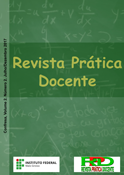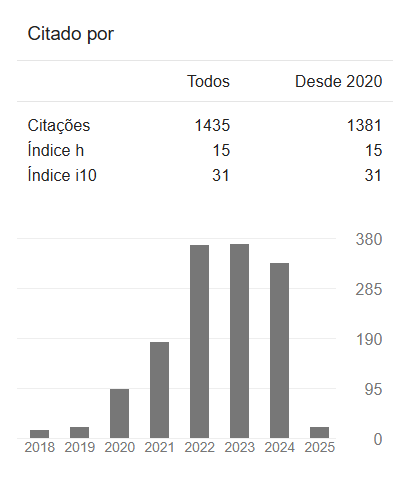THE HEAD OF CALCULATION AND THE DEAF: IMAGINING IN SIGNS
DOI:
10.23926/RPD.2526-2149.2017.v2.n2.p124-137.id58Keywords:
Head calculation, Deaf, Signals, ImagesAbstract
The teaching of mathematics has passed through the ages through transformations, which often affect both the methodological proposals of teachers in the classroom and important issues such as curricular reforms. We realize that in the midst of these changes, the calculus of head has lost space in the classrooms and with this, there is little interest of the researchers in attention to this so important question in the learning of the mathematics. The present article aims to discuss questions about the calculation of head in deaf students taking into account that the deaf have a different way of seeing, we understand that this is indicative of the question: How does the deaf do a head calculation? Evidence indicates that the deaf calculates the head from the use of hands, performing signals. This bibliographic study uses examples from situations experienced by the researchers.
Downloads
Metrics
References
BAKER, C.; PADDEN, C. Focusing on the nonmanual components of American Sign Language. In P. Siple (ed.) Understanding language through sign language research. Academic Press, New York, USA, 1978, 27-57.
BATTISON, R. Phonological deletion in American Sign Language. Sign Language Studies, 5, 1974, 1-19.
BRASIL. Lei n°. 10.436, de 24 de abril de 2002. Dispõe sobre a Língua Brasileira de Sinais -Libras, e dá outras providências. Brasília, 2002.
BRASIL. Decreto n°. 5.626, de 22 de dezembro de 2005. Regulamenta a Lei n°. 10.436, de 24 de abril de 2002 que dispõe sobre a Língua Brasileira de Sinais - Libras, e o Art. 18 da Lei n°. 10.098, de 19 de dezembro de 2000. Brasília, 2005.
CARVALHO, Dione Lucchesi de. Metodologia do ensino da matemática. 4º Ed. – São Paulo: Cortez, 2011.
CENTURIÓN, Marília. Conteúdo e Metodologia da Matemática: Números e operações. Série Didática.2 ª Edição. Ed. Scipione. São Paulo, 1995.
FELIPE, Tanya Amaro. LIBRAS em contexto: Curso básico: Livro do estudante. 8ª ed. Rio de Janeiro: WalPrint, 2007.
GÓMEZ-GRANELL, Carmen. Rumo a uma epistemologia do conhecimento escolar: o caso da educação matemática. In: RODRIGO, M. J.; ARNAY, J. (Orgs.). Domínios do conhecimento, prática educativa e formação de professores. São Paulo: Ática, 1998. p. 15-41.
GONZÁLEZ, E. Necessidades Educacionais Especificas: Intervenção psicoeducacional. Trad. Daisy Vaz de Moraes. Porto Alegre, Artmed, 2007.
HEBECHE, Luiz. O conceito de imaginação em Wittgenstein.Nat. hum. [online]. 2003, vol.5, n.2, pp. 393-421. ISSN 1517-2430.
IFRAH, Georges. Os números: história de uma grande invenção. Tradução de Stella Maria de Freitas Senra. 4 ed. São Paulo, Globo, 1992.
KARAGIANNIS, A.; STAINBACK, W.; STAINBACK, S. Fundamentos do ensinoinclusivo. In: STAINBACK, Susan; STAINBACK, Willian. Inclusão: um guia para educadores. Trad. Magda França Lopes. Porto Alegre: Artes Médicas, 1999.
LACERDA, Cristina Broglia Feitosa de; LODI, Ana Claudia Balieiro. A inclusão escolar bilíngue de alunos surdos: princípios, breve histórico e perspectivas. In: Uma escola, duas línguas: letramento em língua portuguesa e língua de sinais nas etapas iniciais de escolarização. 4. ed. Porto Alegre: Mediação, 2014.
LIMA, Priscila Augusta. Educação inclusiva e igualdade social. São Paulo: Avercamp, 2006.
MACHADO, Paulo César. A política educacional de Integração/Inclusão: um olhar do egresso surdo. Florianópolis: Ed. Da UFSC, 2008.
OLIVEIRA, Janine Soares de. A comunidade surda: perfil, barreiras e caminhos promissores no processo de ensino-aprendizagem em matemática. Rio de Janeiro: CEFET, 2005. Dissertação (Mestrado em Ensino de Ciências e Matemática), Centro Federal de Educação Tecnológica Celso Suckow da Fonseca, 2005.
ROSAT, Jean-Jacques. Calculer “dans as tête”. Le problème philosofique du calcul mental. In: CHAUVIRÉ, C.; LAUGIER, S.; ROSAT. J.J (Orgs.). Wittgenstein: les mots de l’esprit. Paris: VRIN, 2001. (pp.315-332)
SÁ, Nídia Regina Limeira de. Cultura, poder e educação e surdos. Manaus: EDUA, Comped, INEP, 2002.
SKLIAR, Carlos B.(org). Educação e exclusão. Abordagens sócio-antropológicas em educação especial. Mediação, 1997.
STOKOE, W. Sign Language Structure. Silver Springs, Maryland: Linstok Press, 1960.
STROBEL, Karin. As imagens do outro sobre a cultura surda. Florianópolis: Ed. da UFSC, 2008.
TARSKI, Alfred. A concepção semântica da verdade. São Paulo: Ed. Unesp, 2007. (Verdade e demonstração, p. 203-234). O conceito de verdade nas linguagens cotidiana ou coloquial, p. 22-33).
UNESCO. Declaração de Salamanca e linhas de ação sobre necessidades educativas especiais. Brasília: CORDE, 1994.
WITTGENSTEIN, Ludwig. Fichas (Zettel). Lisboa: Edições 70, 1989.
WITTGENSTEIN, Ludwig. Investigações Filosóficas. Rio de Janeiro: Coleção Pensamento Humano, 1996.
WITTGENSTEIN, Ludwig. Los Cuadernos azul y marrón. Madrid: Estructura y Funcion. Editorial Tecnos, 1968.
WITTGENSTEIN, Ludwig. Observaciones a los Fundamentos de la Matemática. Madrid, Alianza, 1978.
WITTGENSTEIN, Ludwig. Observações Filosóficas (OF). Tradução de Adail sobral e Maria Stela Gonçalves São Paulo: Loyola, 2005.
Downloads
Published
How to Cite
Issue
Section
License
Copyright (c) 2023 A Revista Prática Docente tem o direito de primeira publicação

This work is licensed under a Creative Commons Attribution-NonCommercial 4.0 International License.
Authors who publish in this journal agree to the following terms:
- Authors retain the copyright and grant the journal the right of first publication, with the paper simultaneously licensed under the Licença Creative Commons Attribution allows the sharing of the work with acknowledgment of authorship and initial publication in this journal.
- Authors are authorized to take additional contracts separately, for non-exclusive distribution of the version of the work published in this journal (e.g. publish in institutional repository or as a book chapter), with acknowledgment of authorship and initial publication in this journal.











